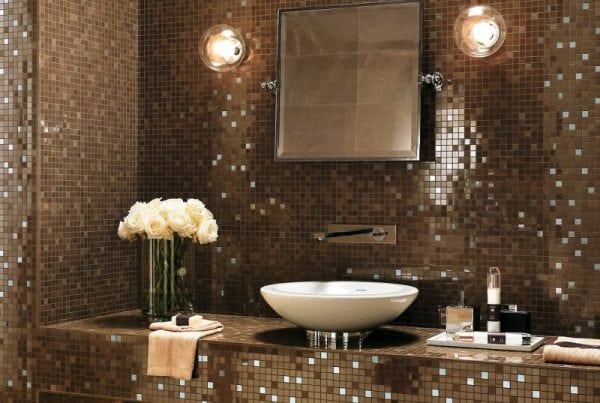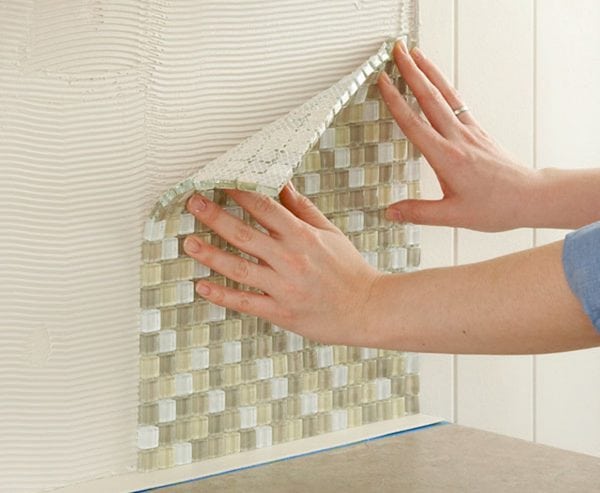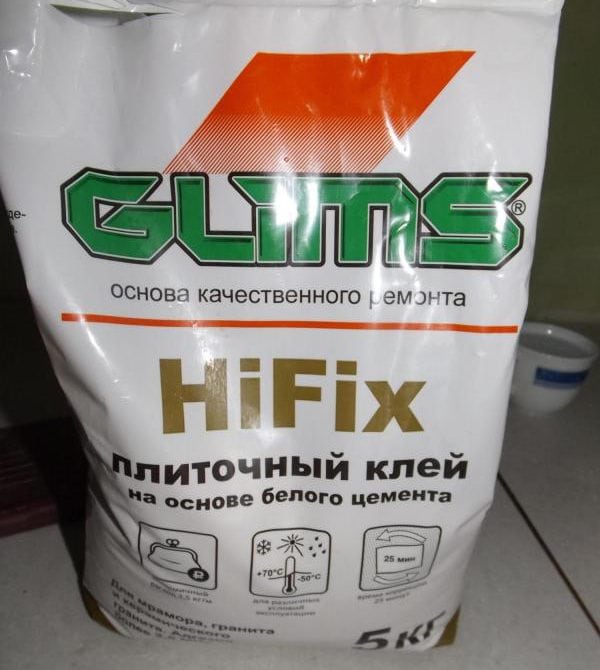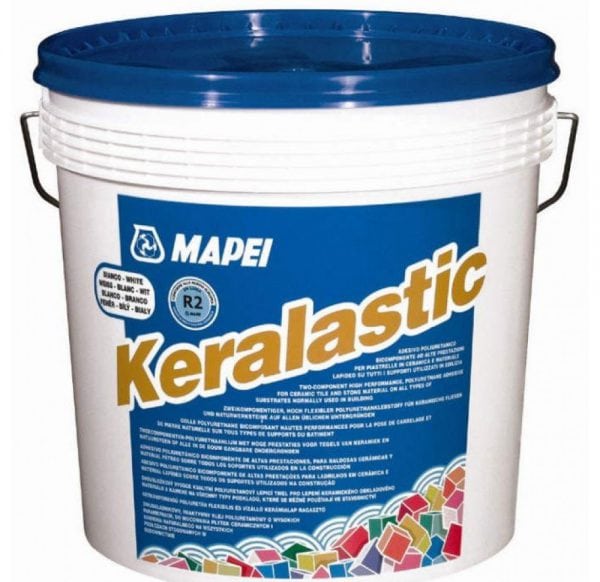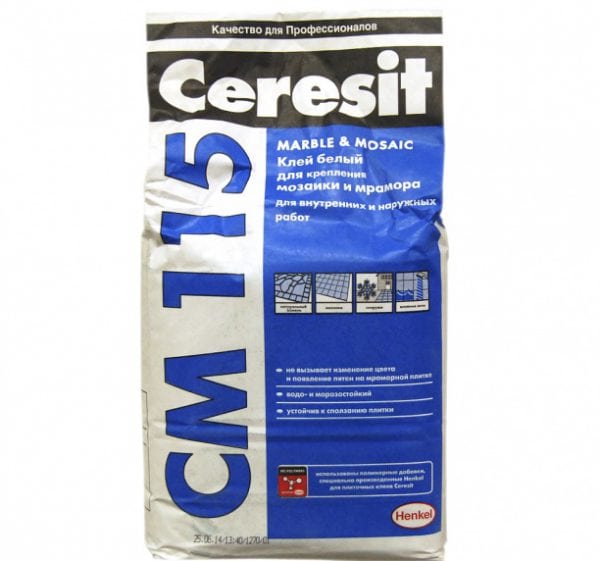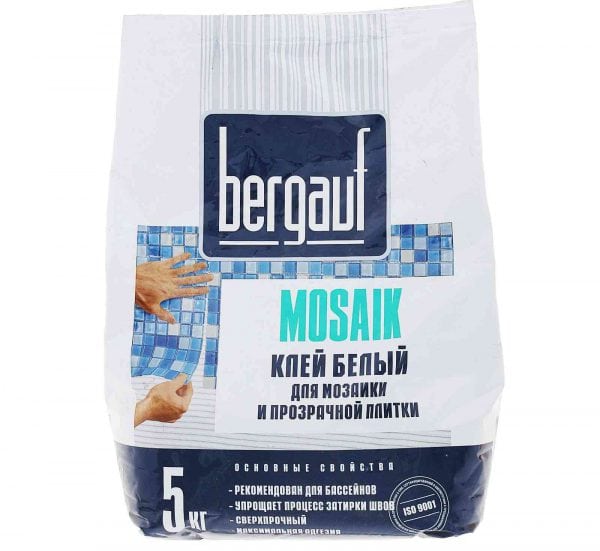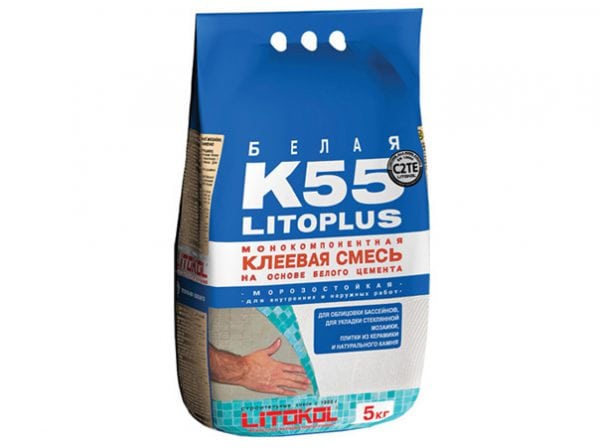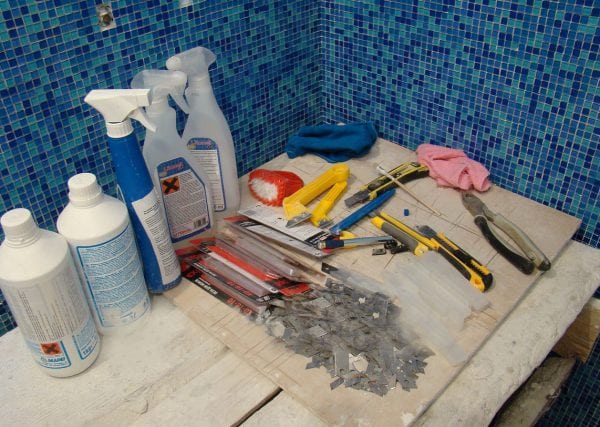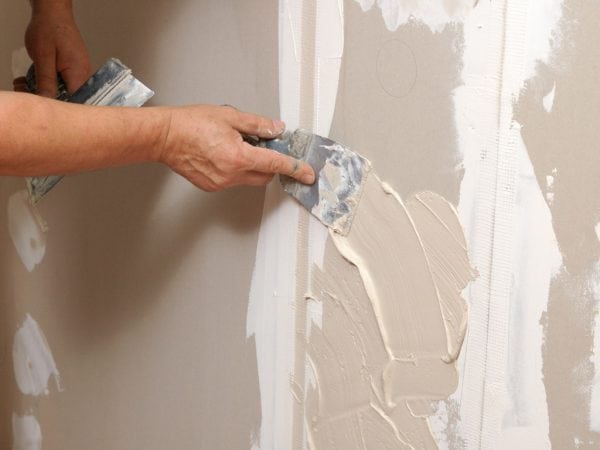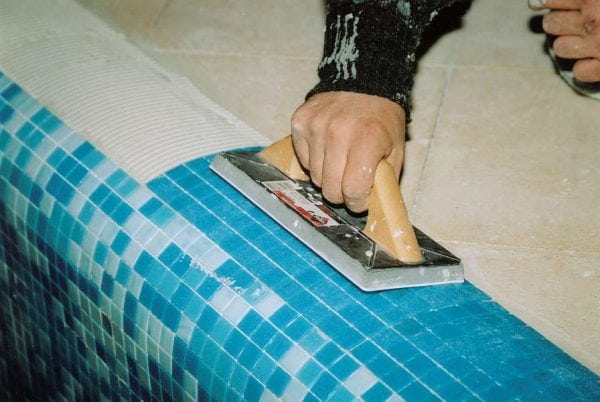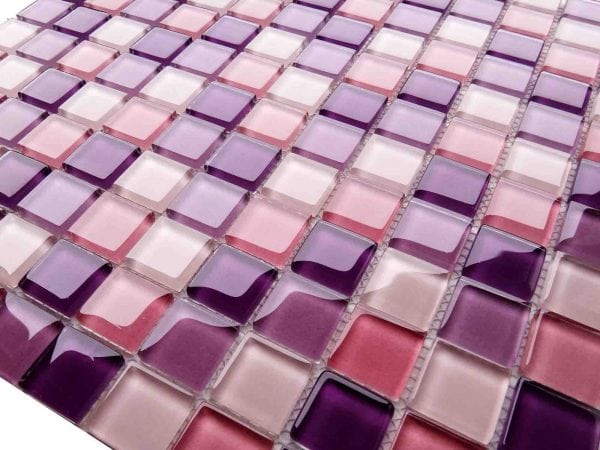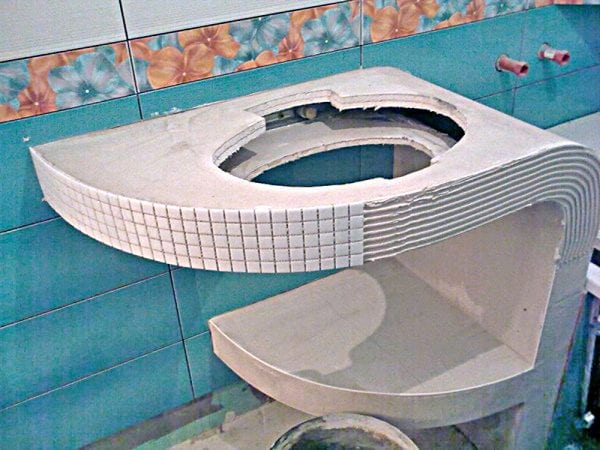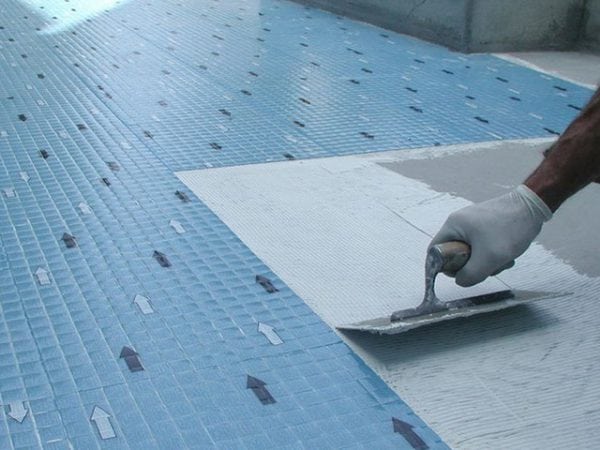Laying mosaics in the bathroom or in the kitchen can be done by yourself, there are no special difficulties in the technology. High-quality preparation of the base, surface leveling and selection of a good adhesive composition are important.
- Glue varieties
- Cement glue
- Dispersion composition
- Two-component adhesive
- Adhesive Manufacturers
- Ceresit CM 115
- Bergauf mosaik
- Axton
- "Litokol K 55"
- Mapey
- Tools and materials
- Technology for gluing mosaics in the bathroom
- Foundation preparation
- Wall marking
- Mosaic
- Gluing mosaic
- Surface cleaning
- Grouting
- Mosaic on a grid or paper
- Bonding surfaces
- On the tile
- On a tree
- On drywall
- Features of gluing certain types of mosaics
- Glass and mirror mosaic - installation features
- Natural stone products
- Plastic mosaic
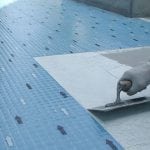
If the wall is uneven, the material will repeat its shape, because it is flexible. Glue for mosaics must also meet a number of requirements - to be reliable, resistant to moisture, mechanical damage. If all the tips are followed, the interior will gain a new look without extra costs.
to contents ↑Glue varieties
How to glue a mosaic? There are several types of suitable glue, it is allowed to use any of them. The tool may contain mineral components, polymers, epoxy or other types of resins. In fact, it is permissible to glue the mosaic with the same materials as ordinary tiles, ceramics. But it is also important to consider the type of base on which the mosaic is supposed to be laid. So, when facing gypsum plasterboard or plaster, ordinary tile adhesives are used, and when gluing wood, plastic, a special tool will be required.
Here are other tips for choosing a quality glue:
- The glass mosaic shines through, so it is better to use a transparent or white composition to fix it. Gray will shine through the glass and spoil the look of the material.
- To save time, it is better to glue the mosaic on quick-drying compounds. They can be bought at any hardware store.
- When laying natural and artificial stone, it is worth buying epoxy adhesive - it increases the moisture resistance of the material.
- If the wall surface is uneven, you should buy highly elastic leveling adhesives.
The mistake is sticking the mosaic onto "liquid nails". This product is difficult to distribute evenly over a large area, it is suitable for spot application. Over time, due to the uneven adhesive layer, some mosaic chips will fall out.
to contents ↑Cement glue
Cement adhesives are sold in bags of 20-30 kg, their price is the lowest in comparison with analogues. They have white or gray color, composed of cement, alabaster, gypsum, sand, a number of plasticizers and fillers.
Before sticking the tile, you need to dilute the dry powder with water, liquid latex, lime milk (the norms are indicated in the instructions). It is important to take only very clean water, otherwise the snow-white composition may darken. The best option for applying cement glue is on concrete or brickwork. Drywall from such a tool can get wet, and glue does not hold well on metal and glass.
to contents ↑Dispersion composition
This glue is a finished material in jars, which consists of mineral components, acrylic additives, water. The tool is more expensive than cement, but the convenience of its use compensates for this drawback. It is very comfortable to work with pasty white mass, it is easy to apply on the wall.
to contents ↑Hardening time - from 30 minutes, so the position of the tile can be adjusted in time. The rest of the mixture is stored for a long time, it does not deteriorate under the packaging lid. In addition to mosaics, the dispersion composition is suitable for gluing tiles, clinker tiles, natural stone, majolica.
Two-component adhesive
Means of a two-component type consist of epoxy resin and hardener or are based on polyurethane. After connecting the components, a solid mass is obtained that is almost impossible to tear off.
It is these materials that are recommended to be used if you need to stick the mosaic to a smooth surface - marble, glass, plastic, metal. Epoxy should also be used to attach ceramics to a wooden surface. Two-component adhesives are used for facing swimming pools, baths, saunas, laundries, because they are waterproof. A minus is the high cost of this type of funds.
to contents ↑Adhesive Manufacturers
On sale you can find domestic and imported brands of adhesives for mosaics. Many modern materials are imported from China. The most popular are described below.
Ceresit CM 115
Glue for marble tiles and glass mosaics Ceresit CM 115 ("Ceresit SM 115") is a white compound for exterior and interior use. It is used for fixing various types of tiles, stone, limestone, glass. The product is suitable for concrete, cement screeds, as well as for heated concrete floors. It has water and frost resistance, resistant to tile slipping, environmentally friendly.
After the introduction of the “Ceresit SS 83” plasticizer, the adhesive mass will be suitable for attaching mosaics to wood, drywall, gypsum, and old tile lining. Glue does not leave stubborn stains, very convenient to use.
to contents ↑Bergauf mosaik
Bergauf Mosaik glue (“Bergauf Mosaic”) for mosaics, tiles and pools is packaged in 5 kg bags, is a mixture of white color based on cement. Also in the composition is fractional sand, modifiers, polymers, mineral fillers.
It is recommended for work on balconies, pasting with a tile and a mosaic of facades, pools, socles, a number of critical bases. It is possible to stick tiles on underfloor heating systems with the resumption of heating 7 days after the end of work. Frost-resistant, highly adhesive, does not respond to moisture.
to contents ↑Axton
Axton special agent is ideal for glass mosaics indoors (bathrooms, kitchens, lobbies, living rooms), as well as fountains and facades on the outside. No less good, it glues stone, ceramic tiles, can be used in the decoration of pools. For the arrangement of warm floors, the material is mixed with latex additives.
"Litokol K 55"
Tile glue “Litokol K 55” - a dry glue mixture for indoor and outdoor use, white cement is the basis of the composition. Helps to glue all types of tiles and mosaics, including glass and natural stone. It can be used in damp rooms, pools. White color does not change the shade of the base material, does not shine through. The composition has high plasticity and excellent adhesion, eliminates the slip of mosaics and tiles on vertical bases.
to contents ↑Mapey
Mapei Adesilex P10 is also included in the group of adhesives based on white cement. It helps to glue even such complex types of mosaics as mirror and glass, used for products from tiles, ceramics, marble. Distinctive qualities of “Mapey” - it does not slip and stays open for a long time without spoiling. The product comes in 25 kg bags.
Tools and materials
To work with mosaics, you should measure the walls or floor, purchase the right amount of basic material - small ceramic, plastic or other type of tile. It is also necessary to buy tile glue. On sale there are various types of adhesive base on which the mosaic will hold perfectly. Here is a list of other materials and tools required for installation:
- grout for seams of mosaic tiles;
- crosses for the formation of joints;
- spatula with cloves;
- rubber spatula;
- gloves
- sponge;
- bucket;
- construction mixer (if the glue is dry).
In the event that a self-adhesive mosaic is purchased, an adhesive composition is not needed. Typically, such material is recommended to be glued to the wall in the kitchen, and in the bathroom with constant contact with water, it does not last long.
to contents ↑Technology for gluing mosaics in the bathroom
It is most convenient to mount mosaic chips on a grid - they are sold in pieces or blocks, even a beginner can cope with them. If required, cut such modules with a construction knife. But how to cut individual elements correctly, because without this repair is unlikely to cost? Usually you have to cut the mosaic near the outlet or at the corners of the walls. Special roller nippers are used, they leave the edges smooth and even.
to contents ↑To cut holes in the canvas, you can remove the desired segments from it, then gently trim the tiles with nippers. It is also permissible to immediately cut a hole of the required size with a grinder.
Foundation preparation
The wall should be perfectly aligned - otherwise, the dimpled glue or unevenness will stand out strongly, individual chips will quickly peel off. The process of preparing the plastered wall is as follows:
- check the surface for voids and seal them with a leveling mixture;
- polish the walls to remove even the smallest irregularities, tubercles;
- on drywall to seal the seams and cover the hats of screws;
- let the wall dry completely;
- brush off dust with a rag, carry out priming to improve adhesion of the surface, reduce its absorbency;
- the tile will be better glued if primed to 2 layers;
- when using transparent tiles in the bathroom, on the countertop in the kitchen, in addition to soil, tinting is used.
Wall marking
Pre-marking is very important, because the individual elements are small, can be shifted during installation. First, make a sketch, then repeat the markings on the walls. It should start from the outer corners (slopes, boxes) or from a mirror, a panel on the wall, or another large decorative element. On the floor it is more convenient to make a dry layout of the material.
Mosaic
The tile is laid at a temperature of + 5 ... + 30 degrees. Begin to glue the modules from the 2nd row. Each element with a pattern is first applied without glue to check the decor.
to contents ↑Mosaic glue hardens quickly. A film on the surface begins to form after 20-30 minutes, so do not immediately dilute a large amount of the product. It is much more convenient to use ready-made compounds. Glue based on resin with one's own hands is bred strictly in the required proportion with the hardener.
Gluing mosaic
The finished adhesive mass is applied to the wall with an even spatula with a layer of 3-4 mm. Further along the glue pass a notched trowel with a tooth height of 3 mm. Specialists sometimes lubricate the mosaic itself with glue, which will provide a more reliable bond. In this case, the layer should be 1-2 mm.
Tiles are usually mounted on the wall from below, but the mosaic is lighter, it can be started to mount from any site. But it is still worth practicing in an inconspicuous area, for example, behind the bathroom. Individual elements are pressed against the wall or floor, using crosses or acting on the eye. After laying, you need to tap the square to remove excess air.
to contents ↑Surface cleaning
After 30 minutes, you can remove the excess glue with a stick, a brush with a hard pile, matches. Cleaning must not be done immediately so that the mosaic does not peel off. After that you can remove the remnants of paper protection, which is on the front side of the blocks.Start from the bottom right row, moving to the last. First, the paper needs to be slightly moistened.
Grouting
For grouting, use two-component mixtures that are suitable for a particular type of material. Ideally, if they contain antifungal components. The work is carried out a day after gluing the mosaic. Dilute the mixture, apply it horizontally and vertically with a rubber spatula. As the grout dries, it is washed off with chips with a sponge, then the surface is polished with a flannel.
Mosaic on a grid or paper
In order not to waste time gluing each element, block mosaic was invented. It is produced in separate squares, fixed on a grid, paper. The pattern is formed from blocks, which is much faster, and the result will be similar, even more beautiful thanks to the even laying.
The glue for this material can be any. It is only important to carefully consider the layout, and in the process of gluing, make sure that the grid is evenly smeared with the solution. Since the tiles are bonded with paper in front, you will have to lubricate the base material, subsequently removing the paper protection.
to contents ↑Bonding surfaces
Depending on the type of substrate on which the mosaic is applied, the specifics of the work may vary. There are a number of features when choosing and applying adhesives to old tiles, wood, drywall.
On the tile
If you do not want to remove the old tile in the bathroom, you can glue the mosaic coating directly on top of it. What glue is used for such work? Ideal silicone or sealant for bonding aquariums. Also for such work, high-quality epoxy adhesive in the form of a two-component composition is suitable. Old tiles must be pre-degreased and cleaned of dirt, soap stains.
On a tree
For this basis, a two-component adhesive or a ready-made dispersion acrylic composition can also be used. But first you should walk 2-3 times on the wood with a primer to minimize the absorption of the material. If it is decided to stick the mosaic onto plywood, then the thickness of the latter should not be less than 0.7 cm. Highly elastic glue is selected, which will not crack under load.
to contents ↑On drywall
Laying the mosaic on drywall is the simplest, the material will hold firmly for a long time. It is important to pre-coat the joints of the sheets with putty, which will increase the reliability of the structure. Then the surface is primed. Attach the mosaic with cement glue, water-dispersible composition.
to contents ↑Features of gluing certain types of mosaics
There are various types of material on sale, but the most popular is still the mosaic made of ceramics. Mirror tile looks original - it increases the space and adds light. Smalt chips are made of opaque glass, which has a unique look. The glass melt is hardened at high temperature, after which it is subjected to special treatment. Such a mosaic is often covered with rhinestones, bead patterns, and beautiful panels are created with its help. Mosaic made of Venetian glass is very expensive, but it allows you to make real masterpieces in the bathroom.
to contents ↑Glass and mirror mosaic - installation features
The glass surface has no pores, therefore it is impervious to water and germs. The material well tolerates the effects of household chemicals, it is great for lining bathrooms. For reliable adhesion of tiles to the wall, it is important to thoroughly wash and degrease the surface. It is advisable to cover it with white paint so that the elements look more elegant. The wall is covered with reliable glue with a transparent base (epoxy, polymer), after which mosaic sheets are laid.
to contents ↑Natural stone products
Stone chips are made of jasper, onyx, marble. Such material looks expensive and very beautiful, especially after additional polishing and artificial aging. The stone has pores, care for it should be neat due to the ability to collapse. The composition should be applied to the back of the modules, so it is better to buy a mosaic on the grid. Use all types of adhesives, the best option is epoxy.
to contents ↑
Plastic mosaic
This option will be a cheap replacement for natural materials. Such mosaic tiles are made of PVC, which is resistant to water and temperature extremes, famous for its durability. To attach such a material, hot melt adhesive and even “liquid nails” can be used. Foamed PVC responds well to all types of adhesives, especially if the surface is well leveled and cleaned. Such a mosaic can imitate wood, stone, glass and helps to make repairs efficiently and at no extra cost.

